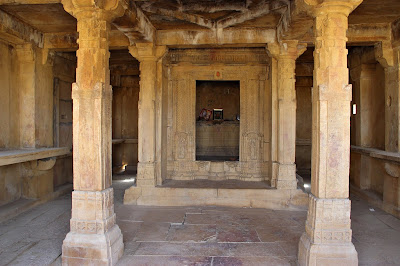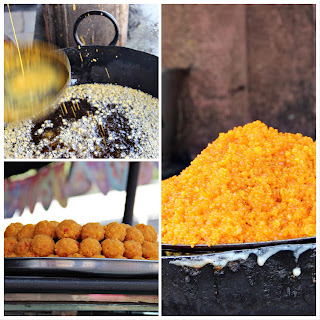Our vibrant land of Rajasthan is rich not only in culture and tradition but also in folklore, tales and stories. Many of these stories are of courage and valour, of sacrifices, of victories and defeats, of love and devotion and some of fear and unusual occurrences. Bhangarh tops the list of the stories that bring intrigue to the fore with Kuldhara a close second. Kuldhara was once a prosperous village and is said to be abandoned in the early 19th century. Let us unravel the mystery that Kuldhara is……
 |
| Kuldhara - First Glimpse |
First the story
Visualise a peaceful quaint village from the Era when there were no telephones, no electricity, no running water, no machines and life was very easy and simple. The world was as big as one’s village. Days were spent doing respective assigned tasks and evenings were spent chatting around, bed time came pretty early; and so did the morning, people would wake up before the sunrise, would tend to their cattle and horses and again would go about with their respective routines. This was Kuldhara, village of the Paliwal Brahmins. In this peaceful village of traders and businessmen, came a little trouble in the name of Saalim Singh. He was the Prime Minister to the King of the Kingdom this village came under. A tyrant of a Prime Minister who would trouble the peace-loving Brahmin folk of this village and neighbouring villages and extort more money from them in the name of unjustified taxes. The ruthless Saalim Singh also harassed the women folk. People were somehow being tolerant and would ignore his misdeeds. But the catastrophe descended on the happy people when Saalim Singh set his eyes upon one of the village belles. Known to have many wives and concubines and having a reputation of ill-treating women, his wish of marrying her was declined by the villagers, which infuriated the already angry Saalim Singh. He did not take this insult too well and his wrath came upon the village in more extortions and more troubles, more cruelties and more harassment. Fed up with this menace, the villagers decided to quietly move away from their much-loved motherland. Not just one or two families but the whole village - lock, stock and barrel!
 |
| Village Square |
“The story gives me goosebumps each time I narrate, hear or read it. But the solidarity of the community leaves me with a very happy feeling and a sense of pride too”, says our guide, one of the locals who has been showing Kuldhara to tourists for many years now.
Other theories to the abandonment are of dwindling water supply and a possible earthquake but the most popular and convincible one is the persecution by Saalim Singh.
Now The village
 |
| Ruins of Kuldhara |
Kuldhara is around 35 km from Jaisalmer and is a day excursion kind of a place. You can visit Kuldhara even on your way out of Jaisalmer while continuing with your tour. The visit does not take more than an hour unless you are a photography enthusiast or a writer because then you will have a million spots in the ruins to let your creativity go unbridled. As you approach the village, a sense of pall and gloom takes over. The ASI has tried to conserve the ruins well and the village is enclosed by a wall protecting the ruins. There is a large gate that lets you into the village. Just as you enter the gate, on the right is a park dedicated to various types of Cacti that thrive in the arid desert of Jaisalmer. This can be visited later, first you must let your curiosity get quenched by visiting Kuldhara. The vehicle will take you right upto the entrance to the village. We were greeted by some very friendly and enthusiastic Indie dogs when we reached there.
 |
| The village |
 |
| Village layout |
In a little distance from the cluster of homes you would notice some beautifully carved domes erected on a small hillock. These are the cremation grounds for the village and these domes were erected as a symbol of respect and remembrance to the people who left this mortal world.
The Homes
 |
| Facade of a home |
The restored house is the model home and mostly all the homes were designed on a similar pattern. There is only one entrance to the home and the main entrance is decorated with hand painted figures of birds and animals. The homes are little higher than the road and hence you need to climb a few steps to get into the ground floor of any house.
 |
| Window between guest area and home |
 |
| Channelising water into the reservoir |
 |
| Garage |
As we move out of the house towards the temple, we noticed a room with no doorway towards the outside of the house. This was a garage and carts were parked here. In fact, the ASI has kept one dilapidated cart also here to give an idea of what it looked like in those days.
The Village Temple
 |
| The village temple |
While the whole village lies in ruins, it is surprising to see The Temple still intact and with deity still being worshipped. Yes, we saw fresh flowers that were offered to the Gods with traces of recently used incense sticks. The Temple was built on a high raised rock platform and was carved out of rock unlike the brick structures of the houses. Maybe that is the reason for the Temple to still be standing and bearing the blows of time. We bowed our heads in respect and entered the temple. A lot of sparrows and squirrels greeted us.
Goodbye Kuldhara
Still in a trance and our heads busy with assimilating all that information and visualising all that was once a lively village filled with happy people, we moved out of Kuldhara. On our way out we stopped over at the Cacti Museum and thereafter just outside the main gate met another WONDER. A centenarian flautist. A double flute, known as Algoza which is a common musical instrument of Western Rajasthan was melodiously played by this gentleman. Do not mistake him for a beggar because he does not want anything from you, he does it for his own pleasure but then a little appreciation and a few gifts have never done any harm to anyone!
A lot has been said and written about Kuldhara, some even calling it a haunted village but, Kuldhara is not haunted, it is an abandoned village. Abandonment not for a curse or any paranormal occurrence but to escape a tyrant. Very believable, isn’t it?
We would love to take you to Kuldhara, write to us here and let's plan a trip.
We would love to take you to Kuldhara, write to us here and let's plan a trip.
 |
| Our Algoza Artist - Sumar Ram Bhil |














